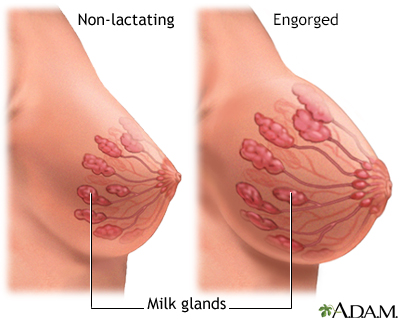| ||||||||||||||||||||||||||||||||||||||||
Breast milk is the best source of nutrition for infants. Breast milk contains appropriate amounts of carbohydrate, protein, and fat. It also provides digestive enzymes, minerals, vitamins, and hormones that all infants require. Breast milk also contains valuable antibodies from the mother that can help the baby resist infections. Studies also suggest that breastfeeding helps mothers lose weight gained during pregnancy, reduces the mother’s risk of diabetes, and that breastfed babies have higher I.Q.’s.
Healthy infants have adequate iron stores to last until 8 months of age. Iron-rich foods can be started at this age. Your pediatrician or dietitian may recommend Fluoride supplementation in communities where water is not fluoridated (areas with less than 0.25 p.p.m. Fluoride), or if you use bottled water.
Cow's milk by itself is inappropriate for infants less than 1 year old. The infant can develop an allergy to dairy products if given cow's milk too early in life. Although cow's milk contains most of the same components as breast milk, these components are not in the same amounts. Cow's milk also lacks the immune factors, called antibodies, that help protect infants until their own immune system fully develops.
Commercially prepared formulas may be based on non-fat cow's milk, whey protein, or soy protein. In order to provide a balanced diet for an infant, formulas are fortified with carbohydrates, fats, minerals, and vitamins. The antibodies found in breast milk, however, can never be added to formulas.
Milk is produced in small sac-like glands (alveoli) in the breast. These sacs develop after specific hormonal (estrogen, progesterone, pituitary prolactin, and placental lactogen) stimulation that begins at four to six months (second trimester) of pregnancy.

The human breast does not store a large volume of milk as cow's do. Most of the milk your baby ingests during breastfeeding is produced during nursing. Suckling stimulates the release of a hormone (prolactin), which stimulates milk production. Suckling also causes the release of another hormone (oxytocin). Oxytocin, in turn, stimulates contraction (or the "let-down reflex") of the milk glands. The milk is squeezed out of the milk gland, into the milk ducts, and into the nipple.
At the beginning of the feeding, the milk is bluish and contains lactose and proteins, but little fat; it is called foremilk. The end of the feeding produces hindmilk. The hindmilk contains more fat, the main source of energy for your baby. If breast milk is allowed to sit for half-an-hour after being expressed, the "cream" separates and settles on top of the watery part. This is because human milk isn't homogenized. Homogenization is the process that makes the water and fat portion in milk stay in "one layer."
Some mothers feel a tingling sensation as the milk begins to eject from the breast due to the let-down reflex. The best way to monitor whether this milk-ejection reflex has begun is by watching the sucking and breathing patterns of your baby. At the start of a feeding, you will notice a pattern such as: suck, suck, suck, swallow, suck, suck, suck, swallow. This pattern may last up to 30 seconds but can be longer. As the milk ejection reflex takes over, the pattern may be described as gulping: one swallow, one deep breath, one swallow, one deep breath. This pattern may last for 2 to 4 minutes. Your baby may want to nurse longer (maybe 15 or 20 minutes) on this breast in order to get more fat from the hind milk or to fill a need for sucking. Mothers used to be told to nurse for 10 minutes a side. Now, experts say to watch your baby, not the clock. Let your baby break off the first breast when he’s ready, and then try switching to the other breast. If she’s not interested, it’s ok to nurse on one side per feeding. Just try to start on the other side next time, so you don’t get lopsided or develop engorgement in one breast.
Your milk supply will be established during the first few days and weeks after the birth of your baby. Nursing early (within the first half-hour), and frequently (on demand, or 8-12 times per day), allows you to nurse comfortably and efficiently. It usually takes less than one minute for an infant to stimulate the milk ejection reflex.
You should feel little discomfort or pain when breast feeding appropriately.
Within 6 and 8 weeks, your milk supply will adjust to your baby's needs. Before that time, your breasts may feel either too full or too empty. Frequent, comfortable feedings will maintain your milk supply. Your milk supply will increase or decrease based on your baby's hunger and the intensity of feeding (milk demand or use). Changes in your milk supply will occur within one to three days after changes in milk demand or use. Every few weeks, your baby may seem to want to eat all the time. It’s thought that this happens when she’s getting ready for a growth spurt. A few days of intense nursing are her way of telling your breasts to increase milk production.
When storing milk for home use, wash your hands before expressing (or pumping). Use containers that have been washed in hot, soapy water and rinsed well, or run them through the dishwasher. Always date the milk before storing it. For more information, see pumping and expressing breast milk.
Refrigerated milk and frozen milk should be warmed under a stream of warm tap water. Never microwave breast milk; overheating destroys valuable nutrients and "hot spots" can scald your baby.
|
Review Date:
12/9/2012 Reviewed By: ZeIrina Burd, MD, PhD, Maternal Fetal Medicine, Johns Hopkins University, Baltimore, MD. Review provided by VeriMed Healthcare Network. |